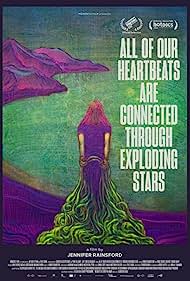Eye For Film >> Movies >> All Of Our Heartbeats Are Connected Through Exploding Stars (2022) Film Review
All Of Our Heartbeats Are Connected Through Exploding Stars
Reviewed by: Jennie Kermode

Since the 11th of March, 2011, each day on Earth has been 1.8 microseconds shorter than those which went before. The reason? The great Tōhoku earthquake was so violent that it shifted the planet’s orbit. It also triggered a devastating tsunami estimated to have killed around 19,300 people. Today, far across the Pacific, the residents of Kaho’olawe, a small island in the Hawaiian archipelago, are still finding Japanese debris on their beaches, assorted reminders of the lives of the lost.
Wildly ambitious and expertly crafted, Jennifer Rainsford’s documentary, which screened as part of Docs Ireland 2023, explores the experiences of tsunami survivors and Kaho’olawe beachcombers in an exploration of grief which also takes in neuropsychology, ocean life and astrophysics, tracing everything back to the humble iron atom which all of us received from the same primordial stars. It’s a film underscored with audio which blends the rhythms of human bodies with the rumblings of volcanoes and ocean waves. Crows look on, calling to each other through watery skies, the only beneficiaries of the destruction. In the sea, ghost nets drift – tangles of fishing nets set loose by the murderous wave and now full of plastic objects, which can last for decades. On one, a Japanese gooseneck barnacle lives with his friends in a state of encrusted, irresolvable togetherness.

We meet a man whose wife was at the bank on the day it happened. When he went looking for her, he was told that everybody there had been swept away. Now he continues to look for her; having searched everywhere on land, he dives down into the ocean. Elsewhere, a woman writes letters to the man she loved, reflecting on the life they shared, looking out across the water from her still intact house on the hillside which he happened to descend at the wrong time. Another, younger woman struggles to cope with survivor’s guilt and the breakdown of friendships caused by increased awareness of life’s fragility, until she finds a reason to reengage with life in an unlikely place.
We plunge into the science of trauma. Survivors’ amygdalas shrank, recovering after a year. Their hippocampi appear to have shrunk permanently, perhaps as a means of shutting down painful memories. This means that they face a higher risk of dementia – the earthquake may yet claim more lives. There is also an increased prevalence of takutsobo cardiomyopathy (also know as broken heart syndrome), a weakening of the heart muscles associated with exposure to extreme stress. Rainsford reminds us that this condition is named for the takutsobo pot which affected hearts come to resemble, a device used to trap octopuses. We see their tentacles twisting together beneath the waves.
Deep beneath the waves – far down in the abyssal zone where no light penetrates – are oarfish, whose visits to the surface are traditionally seen as a harbinger of earthquakes. They and their neighbours feed predominantly on falling plankton. Sometimes it’s easier to make sense of vast existential experiences by focusing on the very small, the transient creatures that swarm and multiply in a drop of water. We spend peaceful moments with these mysterious, elegant creatures, their small bodies filling up the screen.
On the Kaho’olawe beaches, the remains of shattered fishing vessels are heaped together with household items and other, unidentifiable things. Everything is sifted and sorted. A child who must have been born after the earthquake happened contributes to the efforts. Meanwhile, back in Japan, diligent workers set about the task of restoring sea-damaged photos, giving people back the memories they do want to keep, amongst them images of people they will never see again but whose iron atoms have been put to new use by the plankton, drifted right down to the oarfish or worked their way back into the food chain, becoming part of other human beings.
It’s all beautifully filmed, the cinematography pitched just right to blend with archive footage of the wave sweeping through houses and city streets. There isn’t too much of that. We’ve seen it before, and the intent here is not to reinvigorate trauma. The ocean is peaceful now; work is underway on improving warning systems to reduce the risk of Japan being impacted so severely again. Through her collages of stories and images, Rainsford explores the cultural shift precipitated by the disaster, and the different ways of looking at the world which enable people to keep on living in uncertain times. Needless to say, this has much wider value, especially in light of the impact of the pandemic and migration crises. Like the very best films of its kind, All Of Our Heartbeats Are Connected Through Exploding Stars takes all this chaos and finds a point of stillness, a place from which it is possible to begin again.
Reviewed on: 23 Jun 2023















